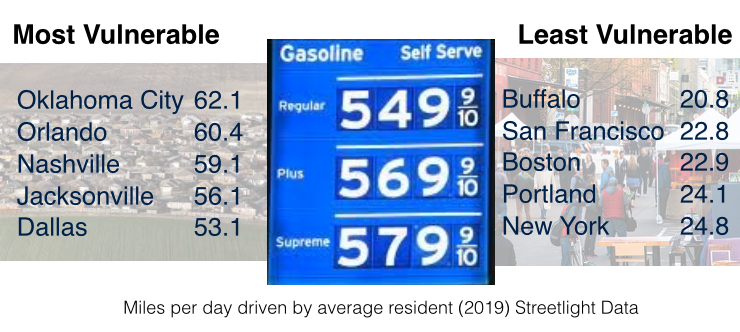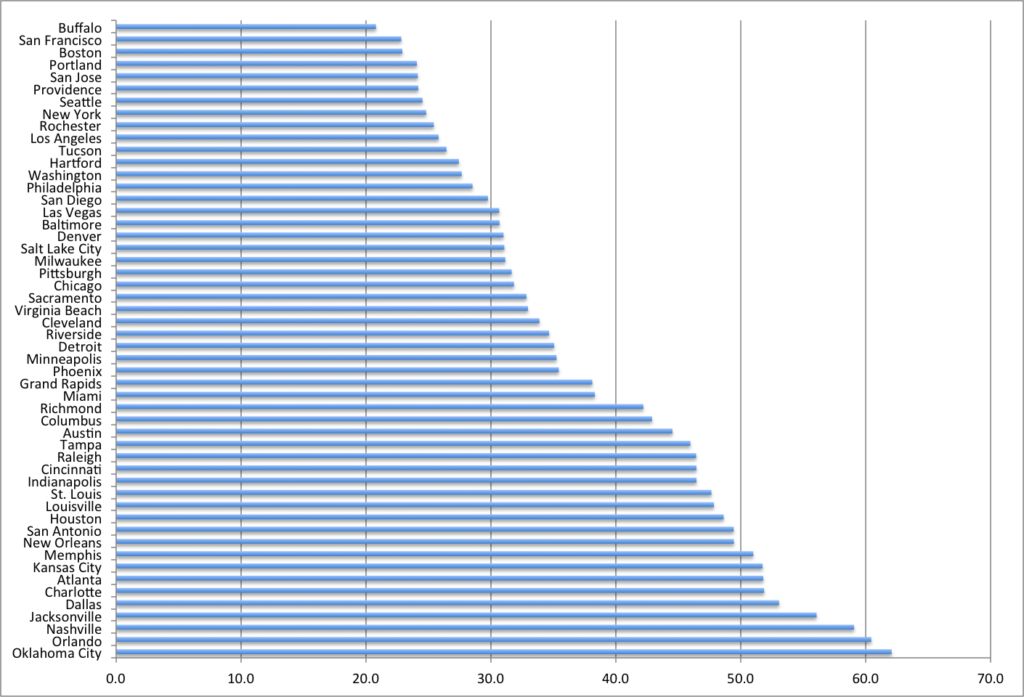Green cities will be less hurt by higher gas prices; Sprawling cities are much more vulnerable to gas price hikes.
In sprawling metros like Atlanta, Dallas, Orlando, Nashville and Oklahoma City, higher gas prices will cost the average household twice as much as households living in compact metros like San Francisco, Boston, Portland and Seattle.
Rising gas prices are a pain, but they hurt most if you live in a sprawling metro where you have to drive long distances to work, shopping, schools and social activities. Some US metros are far less vulnerable to the negative effects of rising gas prices because they have dense neighborhoods, compact urban development, good transit, and bikeable, walkable streets. Among the 50 largest metro areas, the best performers enable their residents to drive less than half as much as the most car-dependent metros. Those who live in metro areas where you have to drive, on average, 50 miles or more per day (places like Oklahoma City, Nashville and Jacksonville) will be hit twice as hard by higher fuel prices than the typical household living in a place like San Francisco, Boston or Portland, where people drive, on average, fewer than 25 miles per day. When gas prices go up, it’s easy being green: These compact, less car-dependent metros and their residents, will experience far less economic dislocation than metros where long daily car trips are built-in to urban form.
Gasoline prices have shot up in recent days, thanks to the Russian invasion of Ukraine. A year ago, average gas prices nationally were under $3 gallon. In February, they averaged around $3.30 per gallon. After the Russian invasion began, oil prices and gas prices jumped. On March 14, the national average was $4.30, and rising rapidly, with much higher prices in some markets.
There’s the usual barrage of media hand-wringing about the impact of high gas prices, notwithstanding the widespread support for backing Ukraine, even if it means higher oil prices. Some 71 percent of Americans favored banning Russian oil imports even at the cost of higher gas prices. As high as they seem, gas prices today are just now approaching the levels recorded in 2008, when gas prices peaked at $5.09 per gallon (in 2022 dollars).
In our largely car-dependent nation, higher gas prices feel painful, but some Americans feel the pain far more deeply than others, and some feel it not at all. There’s been more than a little bike advocate schadenfreude on Twitter, pointing out that those who travel by bike or on foot aren’t feeling the pain of higher gas prices.
I want to apologize on behalf of the bike/walk/transit people if we seem smug about gas prices. It’s just… this is the moment we have been preparing for our entire lives 😂
— Angie Schmitt🚶♀️ (@schmangee) March 11, 2022
But this isn’t just about individual choices and behavior: whole communities can be more or less vulnerable to gas price shocks, depending on how much land use patterns effectively necessitate driving.
Some metro areas are vastly more car-dependent than others, and as a result, are more vulnerable to gas price hikes. We can get a good idea of which metros will be most affected by price hikes by looking at data on average travel distances in different cities. The big data firm Streetlight Data published its estimates of the amount of daily driving per person for large US metros. We’ve tabulated their publicly released data for the period just before the advent of the Coronavirus pandemic, to get a reasonable baseline for comparing travel patterns.
On average, the residents of the typical large metro area in the US drive about 30 miles per person per day (that’s a bit higher estimate than the one provided by the US Department of Transportation). But there are extremely wide variations in average driving among metro areas. In general, older, denser metros with more extensive transit systems seem to have dramatically less driving per person than newer, sprawling Sunbelt metros with weak transit.
The metros least likely to feel the pain of higher gas prices include Buffalo, San Francisco, Boston, New York, Portland and Seattle, where metro residents drive about 25 percent less than average.
On the other hand, the metros most vulnerable to higher gas prices are those where, due to job and population sprawl, people tend to drive much further. These highly vulnerable metros include Oklahoma City, Orlando, Nashville, Dallas, Charlotte and Atlanta, where the typical resident drives 50 or more miles per day, according to the Streetlight estimates, nearly double the typical metro area.
Average Miles Driven Per Person Per Day Prior to Covid-21 Pandemic (Streetlight Data)
As we’ve pointed out before, residents of more compact metro areas, with better transit and closer destinations earn the equivalent of a huge green dividend, even when gas is cheap, because they spend far less on cars and gasoline. Meanwhile, their counterparts in decentralized metros pay a “sprawl tax.” When oil prices rise, the pain falls disproportionately on those who live in metros where they have to drive a lot.
The differences are significant. The households living in metros where people drive 50 miles per person per day are conservatively buying twice as much fuel as those living in metros where people drive only 25 miles per day. So while a family in a compact metro area would be buying say 100 gallons or so of fuel a month, its counterpart in a sprawling metro would be buying 200 gallons. So a $1 increase in the price of gas would hit about $1,200 harder over the course of a year in a sprawling metro than in a compact one.
In the face of rising fuel prices—whether from a war, or from the the long overdue need to reflect the true social and environmental costs associated with fossil fuels—communities where people don’t have to drive as much, or drive as far, have a real economic advantage over more car-dependent places. That’s a consideration that ought to play a larger role in local, state and national policies going forward.


